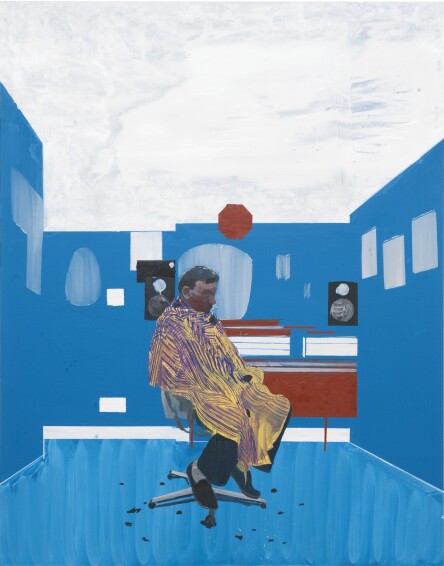- 34
Hurvin Anderson
Description
- Hurvin Anderson
- Peter's Sitters 3
- signed, titled and dated (Jan) 2009 on the overlap
- oil on canvas
- 187 by 147cm.; 73 5/8 by 57 7/8 in.
Provenance
Acquired directly from the above by the present owner in 2009
Exhibited
Harlem, The Studio Museum, Hurvin Anderson, Peter’s Series 2007-2009, 2009
St. Petersburg, The State Hermitage Museum; and London, The Saatchi Gallery, Newspeak: British Art Now, 2009-10, p. 3, illustrated in colour and pp. 9-10, illustrated in colour (London catalogue)
Adelaide, The Art Gallery of South Australia, British Art Today, 2011, p. 41, illustrated in colour
Birmingham, Ikon Gallery, Hurvin Anderson: Reporting Back, 2013, p. 87, illustrated in colour
Literature
Edward Booth-Clibborn, Ed., History of the Saatchi Gallery, London 2011, p. 814, illustrated in colour
Condition
"In response to your inquiry, we are pleased to provide you with a general report of the condition of the property described above. Since we are not professional conservators or restorers, we urge you to consult with a restorer or conservator of your choice who will be better able to provide a detailed, professional report. Prospective buyers should inspect each lot to satisfy themselves as to condition and must understand that any statement made by Sotheby's is merely a subjective, qualified opinion. Prospective buyers should also refer to any Important Notices regarding this sale, which are printed in the Sale Catalogue.
NOTWITHSTANDING THIS REPORT OR ANY DISCUSSIONS CONCERNING A LOT, ALL LOTS ARE OFFERED AND SOLD AS IS" IN ACCORDANCE WITH THE CONDITIONS OF BUSINESS PRINTED IN THE SALE CATALOGUE."
Catalogue Note
According to Anderson the practice of converting a small attic into a barbershop or another type of social space was common amongst first wave Afro-Caribbeans when they arrived in Britain. Not only were these spaces where one could get their hair cut but they were places of entertainment, locales where communities could come together and socialise. As Anderson expands, “it is not only a personal space loaded with imagery, but it also bears the stamp of political, economic and social history” (Hurvin Anderson in conversation with Thelma Golden in: Exhibition Catalogue, London, Tate Britain, Art Now: Hurvin Anderson Peter’s Series 2007-2009, 2009, n.p.). The barbershop imagined in Peter’s Sitters 3 is derived from a distinct memory that the artist has of picking his father up from a haircut one day. He at once became entranced by the magical presence of the room, as though it were a relic of a mysterious other land. It was only later when examining photographs of the attic that, “I realised that there was something about the figure in the chair and the whole nature of that intimate but shared space that was compelling and that I wanted to paint” (ibid.).
Not originally intended as a series, Anderson started Peter’s Series in 2007 with Peters I, which is held in the Government Art Collection, and Peter's II; richly detailed, textured records of the barbershop space that are void of figurative content. By Peters III, however, he had removed all the furniture in a painterly exercise that explored the very qualities of paint and space itself, creating a featureless abstracted blue room. Speaking of why he ended up creating eight renditions of this theme, the artist explained: “the barbershop became such a complex and ambiguous place that I felt compelled to return to it again and again” (ibid.). Not initially ready at the beginning of the series to introduce the figurative, in the last three works of the group – Peter's Sitters 1, Peter's Sitters 2, which is held in the Zabludowicz Collection, and Peter’s Sitters 3 – Anderson turned his brush to address the relationship between the barbershop client and the viewer. To designate that these last three works included figures, and to contrast the earlier 'Peters' works which denoted the empty space of the barber shop, Anderson altered their names to include the word 'Sitters' alongside 'Peter's'. Achieving full figuration in the present and final work of the series, the customer is pictured hunched over in the barber’s chair, “it had become clear to me [by Peter’s Sitters 3] that the customer had become the central subject of the paintings” (ibid.). Scattered around the figure we see tufts of the client’s clipped hair that appear to melt into the cobalt carpet and figuration appears to turn back into abstraction once more.

